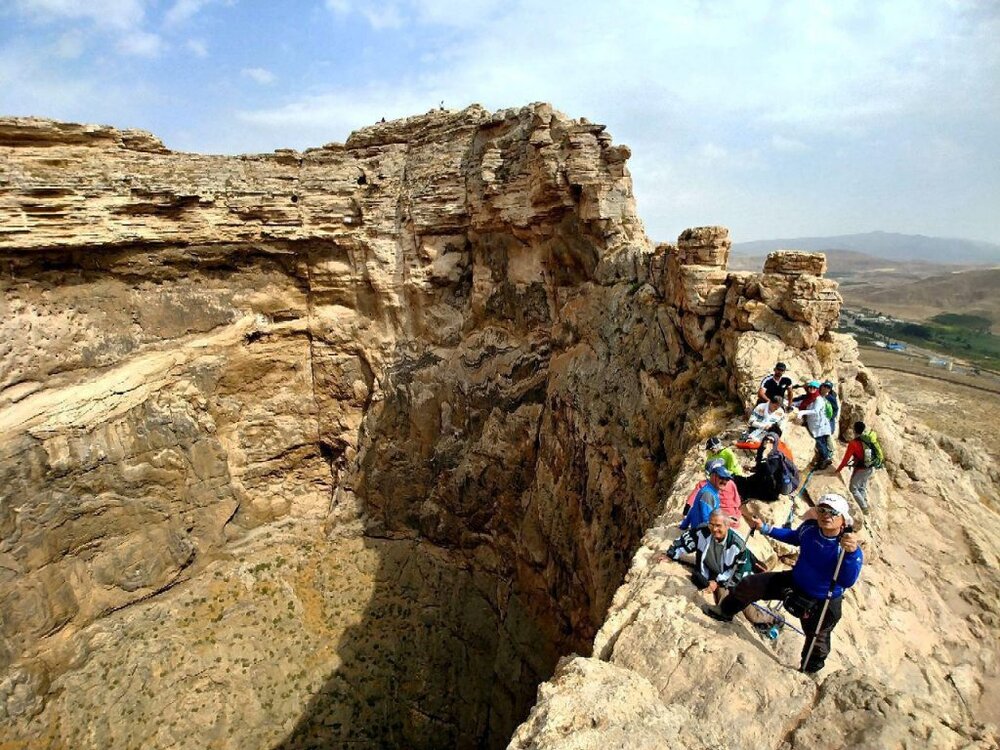Soleyman Prison: a conical peak with fascinating history

TEHRAN - Soleyman Prison (“Zendan-e Soleyman” in Persian) is situated in a dramatic 97m conical peak that dominates the valley landscape for miles around in northwest Iran.
Though there is no construction visible to modern sightseers, the cone was once enclosed by fortified walls and topped by a religious sanctuary that archaeologists suggest dated to 900 BC.
As an avid visitor, if you are reasonably fit, climbing to the crater’s edge should take less than 15 minutes. The path is muddy but obvious, zigzagging up from the nearby Takab road about 4km south of the main Takht-e Soleyman ruins.
Meaning “Solomon’s Prison”, the site did not gain its great religious significance until the early Sassanid period when Takht-e Soleyman—then known as Shiz—was established as a Zoroastrian religious sanctuary (in all likelihood having replaced nearby Zendan-e Soleyman as an earlier center of cult activity) in the early to mid-5th century CE.
The UNESCO-registered Takht-e Soleyman (“Solomon’s Throne”) is an ancient isolated sanctuary that bears testimony to various eras of the nation’s history. It is situated in the southeastern highlands of West Azarbaijan province overlooking a lake with a backdrop of a snowcapped mountain range.
Takht-e Soleyman also embraces a fire temple, which was originally constructed of mud-brick (although foundations were generally of rough stone), but large sections of the complex, including the fire temple itself, were rebuilt of stone and fired bricks in subsequent centuries. The fire temple is flanked on either side (east and west) by two other cultic structures. To the west, on the other side of a long central hallway, a second fire temple may have served as a personal place of worship for the royal family. Situated to the east of the main fire temple was the temple of the goddess Anahita, who had particular importance to the royal house and the warrior class—both of which were served by the local fire altar.
According to Britannica Encyclopedia, the surrounding landscape of the sanctuary was probably first inhabited sometime in the 1st millennium BC. Some construction on the mound itself dates from the early Achaemenian dynasty (559–330 BC), and there are traces of settlement activity from the Parthian period.
UNESCO says the site has strong symbolic and spiritual significance related to fire and water – the principal reason for its occupation from ancient times – and stands as an exceptional testimony of the continuation of a cult related to fire and water over some 2,500 years. “Located here, in a harmonious composition inspired by its natural setting, are the remains of an exceptional ensemble of royal architecture of Persia’s Sasanian dynasty (3rd to 7th centuries). Integrated with the palatial architecture is an outstanding example of a Zoroastrian sanctuary; this composition at Takht-e Soleyman can be considered an important prototype.”
Moreover, the 10-ha property includes Tepe Majid, an archaeological mound culturally related to Zendan-e Soleyman; the mountain to the east of Takht-e Soleyman that served as a quarry for the site; and Belqeis Mountain 7.5 km to the northeast, on which are the remains of a Sasanian-era citadel. The archaeological heritage of the Takht-e Soleyman ensemble is further enriched by the Sasanian town (which has not yet been excavated) located in the 7,438-ha landscape buffer zones.
Under travelers’ eyes
Here is a selection of comments that visitors to the mountainous site have posted to TripAdvisor, one of the most popular travel websites in the world:
“A volcanic mountain with history”
Evil spirits were once locked up in this mountain. This is the story. True or not, it doesn’t matter. The mountain is impressive and near the historic site of Takht-e Soleyman. It is worth climbing the edge of the volcano and look inside, and smell ... the devilish smell of sulfur. (marekp59 from Gdansk; reviewed Jun. 2019)
“Difficult to climb”
This is a hugely impressive site with an amazing history. It stands out from the landscape amazingly. I managed to climb three-quarters of the way up but found it too steep and difficult to reach the top and so was hugely disappointed. My husband and our guide got to the top and told me about the wonderful, deep pit at the top. Most people would manage the ascent. (Sus1952 from Palmerston North, New Zealand; reviewed: Apr. 2019)
“Wow an amazing place”
This is well worth the climb to get to the top. Looking down into the crater was a great experience. Also stunning views from the top. Be aware there are no bathrooms. (Youngone51 from New Plymouth, New Zealand; reviewed Oct. 2017)
“Doorway to Hell”
A small hill just off the road and a 10-min climb to look into this volcanic crater from the rim. It's very worthwhile! (Markus U from Modling, Austria; Reviewed August 2017)
AFM
Leave a Comment